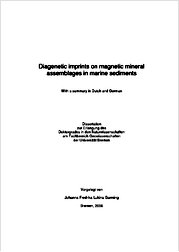| dc.contributor.author | Garming, Johanna Fredrika Lukina | |
| dc.date.accessioned | 2010-10-12T19:29:07Z | |
| dc.date.available | 2010-10-12T19:29:07Z | |
| dc.date.issued | 2006 | |
| dc.identifier.uri | http://hdl.handle.net/11858/00-1735-0000-0001-31F0-4 | |
| dc.description.abstract | Diagenesis, Rock magnetism, Marine sediments. - Sediments and sedimentary rocks are important sources for paleomagnetic studies of the geomagnetic field behaviour and of environmental changes. These studies are greatly dependent on the reliable extraction of the detrital magnetic signal. Overprinting of this signal by reductive diagenetic processes, where iron-bearing minerals are dissolved and secondary (magnetic) sulphide minerals form, jeopardizes the validity of such investigations. It is therefore necessary to be aware of the possible presence of diagenetic/authigenic magnetic phases, i.e. greigite, and their influence on the paleomagnetic signal. A chemical remanent magnetisation (CRM) due to these phases can obscure the detrital magnetic signal. It remains to be shown how primary detrital minerals may survive dissolution under these conditions, and by which mechanisms secondary (magnetic) sulphide minerals are formed. | |
| dc.format.extent | 118 S. | |
| dc.format.mimetype | application/pdf | |
| dc.language.iso | eng | |
| dc.publisher | Univ. Bremen | |
| dc.rights.uri | http://e-docs.geo-leo.de/rights | |
| dc.subject.ddc | 538.7 | |
| dc.subject.ddc | 552.5 | |
| dc.subject.ddc | 550 | |
| dc.subject.gok | TOT 310 | |
| dc.subject.gok | VKB 323 | |
| dc.subject.gok | TOT 310 | |
| dc.subject.gok | VKB 323 | |
| dc.title | Diagenetic imprints on magnetic mineral assemblages in marine sediments | |
| dc.type | monograph | |
| dc.subject.gokverbal | Gesteinsmagnetismus {Geophysik} | |
| dc.subject.gokverbal | Sedimentphysik | |
| dc.identifier.doi | 10.23689/fidgeo-353 | |
| dc.identifier.ppn | 514461802 | |
| dc.type.version | publishedVersion | |
| dc.relation.collection | Geophysik | |
| dc.description.type | thesis | |


